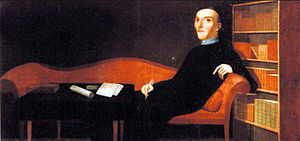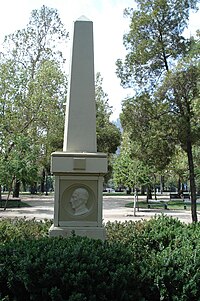Camilo Henriquez
José Camilo Henríquez González (Valdivia, July 20, 1769-Santiago, March 16, 1825) was a Chilean priest, writer and politician, hero of the independence of his country and of South America. He wrote several essays, in particular the Proclamation of Quirino Lemáchez , where he promoted Chilean independence and social freedom.
Biography
Childhood
Camilo Henríquez was born in 1769 in a house that belonged to his maternal grandmother, Margarita de Castro, located in what corresponds to the current Yungay street, in the city of Valdivia, Chile. His parents were the Spanish infantry captain Félix Henríquez y Santillán (1745-1798) and Rosa González y Castro (1747-1798). Although a native of Valdivia, Henríquez spent most of his youth away from that city. When he was nine years old, he was sent to Santiago to begin his formal education at the Convictorio Carolino.
Religious Life
In 1784, he was sent to study in Lima under the direction of his maternal uncle Juan Nepomuceno González, a member of the order of the Ministers of the Dying Sick of San Camilo de Lelis. In the capital of the viceroyalty of Peru, he received education in a convent of the order of his uncle. There, in particular, he was a student of Fray Isidoro de Celis, author of works on logic, mathematics and physics, and a strong defender of science, rationalism and humanism. Henríquez entered the order of the Ministers of the Dying Sick of San Camilo de Lelis, or "de la Buena Muerte", after submitting a clean blood report from his ancestors in 1789, and professed as a priest on January 28, 1790. Later, he went into cloisters to continue his studies. There he befriended José Cavero y Salazar, a fellow student who would later become a leading member of Peru's first independent government and ambassador to Chile. During his stay in Lima, Henríquez frequented literary circles and associated with members of local society.
Spanish Inquisition
In 1809, Henríquez is arrested and interrogated by the Spanish Inquisition. Historian Miguel Luis Amunátegui notes that Henríquez was always secretive about the reasons for his imprisonment and that the claims made in this regard by historians are speculative. However, the most commonly cited explanation for this is that he was reading, or possessed, forbidden books. Henríquez had been heavily influenced by French Enlightenment philosophy in his early years and began reading literature that had previously been banned by the Spanish government, such as El contrato social, by Jean- Jacques Rousseau, who was also in the Index librorum prohibitorum et expurgatorum, and The year 2440, if ever there was a dream (in French L' an 2440, rêve s'il en fut jamais), by Louis-Sébastien Mercier. After his release, his superiors in the Order of the Good Death sent him to Quito to found a new convent for the order.
Writer, journalist and politician
In Quito, Henríquez witnessed the violence of the Royalist Army in America in 1809. Later, he wrote about his experiences in La Camila or La patriota de Sud-América, a sentimental drama in four acts published in 1817, the most famous of his two plays, in which he tells the story of a Creole family fighting for the freedom of the Latin American continent. In 1811 he returned to Chile and became involved in political life.
He wrote the Proclamation of Quirino Lemáchez, a pseudonym created with an anagram of his name, which circulated on January 6, 1811, with the aim of promoting the election of men with independentist ideas in the upcoming elections to elect the First National Congress, becoming one of the first and most important revolutionary essays promoting the independence of Chile and, furthermore, representing the growing popularity of independence among the educated Chilean Creole elite. In it, Camilo Henríquez wrote:
- You are not slaves: none can command you against your will. Did you get any patents from heaven that prove you should be sent? Nature made us equal, and only by force of a free, spontaneous and voluntarily celebrated covenant, can another man exercise upon us a just, legitimate and reasonable authority. But there is no memory that there had been such a covenant among us. Neither did our parents [...] It was therefore written, O people!, in the books of the eternal destinies, that ye should be free and conspicuous by the influence of a vigorous Constitution and a code of wise laws; that ye should have a time, as they have had it, and shall have all the nations, of splendor and greatness; that ye occupy an illustrious place in the history of the world, and that was said some day: the Republic, the majesty of Chile,
Quirino Lemáchez Proclamation
The essay caught the attention of many readers in Europe, where it was reprinted, and despite the fact that his true identity had not yet been made public, his writings instantly catapulted him to fame in Chile.
After the seizure of power by the First National Government Junta, Henríquez was part of the patriot force that quelled the counterrevolutionary Mutiny of Figueroa, on April 1, 1811.
In the First National Congress he was substitute deputy for the Puchacay Party. He also delivered a sermon at the opening mass of the sessions in which he argued that the Catholic Church empowered Congress to produce a national constitution.
Despite his forays into the political arena, Henríquez was perhaps best known for his lifelong newspaper contributions and advocacy: he wrote for numerous newspapers and edited at least ten in Santiago and Buenos Aires. On January 16, 1812, he became the first editor of the Aurora de Chile , the first Chilean newspaper, which used a printing press brought from the United States. The first issue was published on February 13 of that same year. Henríquez used the newspaper as a means to advocate revolutionary values and defend the new spirit of education and reason that, he believed, came with the Aurora from Chile:
- It is already in our power, the great, the prescious instrument of universal illustration, the Printing [...] The voice of reason, and of truth will be heard among us after the sad, and insufferable silence of three centuries [...] Centuries of infamy, and of crying!
Aurora de Chile (Original spelling)
Henríquez described himself as an educator and a philosopher, and his publications often reflect revolutionary political ideals and Enlightenment concepts, especially Rousseau's, of personal freedom and social freedom.
Between 1812 and 1814 he was a senator, and in 1813 he was president of the Senate. He was the author of several bills, including the Constitutional Regulation of 1812 and the protection of indigenous people. During that time, Henríquez staged the play The Procession of Fools.
Due to the censorship established by the government of José Miguel Carrera, El Monitor Araucano began to be published under the direction of Camilo Henríquez, replacing Aurora de Chile, whose first issue was published on April 17, 1813. It also published the Catechism of the Patriots within the pages of the new newspaper.
He wrote the lyrics of the first "Hymn of the National Institute", which was sung on August 10, 1813.
After the battle of Rancagua, where his brother José Manuel died defending one of the trenches in Rancagua square, he went to Mendoza and then continued on to Buenos Aires, where he collaborated with La Gazeta de Buenos Ayres and directed The Censor. There he also wrote two plays, Camila o la Patriota de Sud-América, set in an Omagua village in the Amazon jungle, and Innocence in the asylum of virtue, located in Filadelfia. After the Reconquest, he returned to Chile at the request of Bernardo O'Higgins, returning to work for the newspapers in Santiago. He was appointed librarian of the National Library and was commissioned to edit La Gaceta Ministerial de Chile and another bulletin on the country's administration, which was the forerunner of journalism in Chile.
In 1823 he was a substitute deputy for Chiloé, at that date still a royalist territory outside Chilean control, and later he was a substitute and titular deputy for Copiapó in 1824. During this time, Henríquez was one of nine members of the conservative Senate, created to advise Ramón Freire, the new Supreme Director of Chile.
Camilo Henríquez González died in Santiago on March 16, 1825, declaring a period of national mourning by the government.
Contenido relacionado
834
688
1389



